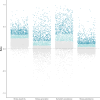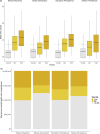Stress dynamics that maintain posttraumatic stress disorder across 20 years
- PMID: 40384227
- PMCID: PMC12094632
- DOI: 10.1017/S0033291725000686
Stress dynamics that maintain posttraumatic stress disorder across 20 years
Abstract
Background: Posttraumatic stress disorder (PTSD) is often chronic and impairing. Mechanisms that maintain symptoms remain poorly understood because of heterogenous presentation. We parsed this heterogeneity by examining how individual differences in stress-symptom dynamics relate to the long-term maintenance of PTSD.
Methods: We studied 7,308 trauma-exposed World Trade Center responders who self-reported PTSD symptoms and stressful life events at annual monitoring visits for up to 20 years (average = 8.8 visits; [range = 4-16]). We used multilevel structural equation models to separate the stable and time-varying components of symptoms and stressors. At the within-person level, we modeled stress reactivity by cross-lagged associations between stress and future symptoms, stress generation by cross-lagged associations between symptoms and future stress, and autoregressive effects represented symptom persistence and stress persistence. The clinical utility of the stress-symptom dynamics was evaluated by associations with PTSD chronicity and mental health care use.
Results: Stress reactivity, stress generation, and symptom persistence were significant on average (bs = 0.03-0.16). There were significant individual differences in the strength of each dynamic (interquartile ranges = 0.06-0.12). Correlations among within-person processes showed some dynamics are intertwined (e.g. more reactive people also generate stress in a vicious cycle) and others represent distinct phenotypes (e.g. people are reactive or have persistent symptoms). Initial trauma severity amplified some dynamics. People in the top deciles of most dynamics had clinically significant symptom levels across the monitoring period and their health care cost 6-17× more per year than people at median levels.
Conclusions: Individual differences in stress-symptom dynamics contribute to the chronicity and clinical burden of PTSD.
Keywords: internalizing psychopathology; life events; life stress; longitudinal; multilevel structural equation model.
Conflict of interest statement
The authors have no conflicts of interest to declare.
Figures




Similar articles
-
Is Posttraumatic Stress Disorder in a Class of Its Own? Longitudinal Comparison to Other Conditions Following Trauma and Life Stress Exposure.J Clin Psychiatry. 2025 May 12;86(2):24m15591. doi: 10.4088/JCP.24m15591. J Clin Psychiatry. 2025. PMID: 40392715
-
Post-disaster stressful life events and WTC-related posttraumatic stress, depressive symptoms, and overall functioning among responders to the World Trade Center disaster.J Psychiatr Res. 2015 Feb;61:97-105. doi: 10.1016/j.jpsychires.2014.11.010. Epub 2014 Nov 24. J Psychiatr Res. 2015. PMID: 25499737
-
Long-term posttraumatic stress symptoms among 3,271 civilian survivors of the September 11, 2001, terrorist attacks on the World Trade Center.Am J Epidemiol. 2011 Feb 1;173(3):271-81. doi: 10.1093/aje/kwq372. Epub 2010 Dec 29. Am J Epidemiol. 2011. PMID: 21190987
-
[Posttraumatic stress disorder (PTSD) as a consequence of the interaction between an individual genetic susceptibility, a traumatogenic event and a social context].Encephale. 2012 Oct;38(5):373-80. doi: 10.1016/j.encep.2011.12.003. Epub 2012 Jan 24. Encephale. 2012. PMID: 23062450 Review. French.
-
Post-Traumatic Stress Disorder among Survivors of the September 11, 2001 World Trade Center Attacks: A Review of the Literature.Int J Environ Res Public Health. 2020 Jun 17;17(12):4344. doi: 10.3390/ijerph17124344. Int J Environ Res Public Health. 2020. PMID: 32560511 Free PMC article. Review.
References
-
- Asnaani, A., & Hall-Clark, B. (2017). Recent developments in understanding ethnocultural and race differences in trauma exposure and PTSD. Current opinion in psychology, 14, 96–101. - PubMed
-
- Asparouhov, T., & Muthén, B. (2021). Bayesian estimation of single and multilevel models with latent variable interactions. Structural Equation Modeling, 28(2), 314–328. 10.1080/10705511.2020.1761808 - DOI
-
- Boasso, A. M., Steenkamp, M. M., Nash, W. P., Larson, J. L., & Litz, B. T. (2015). The relationship between course of PTSD symptoms in deployed US Marines and degree of combat exposure. Journal of Traumatic Stress, 28(1), 73–78. - PubMed
MeSH terms
Grants and funding
LinkOut - more resources
Full Text Sources
Medical

